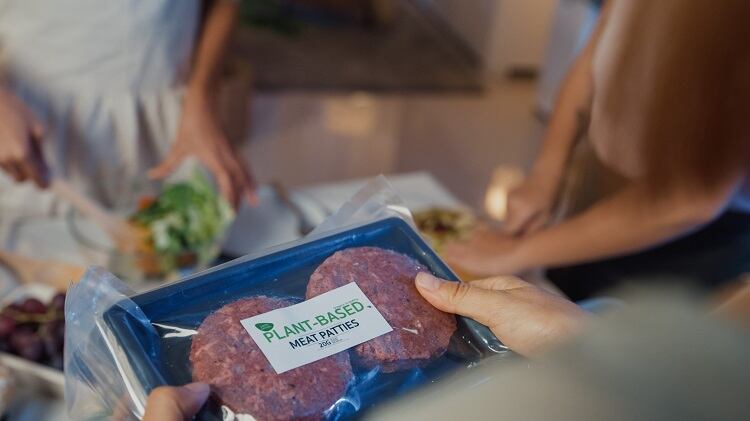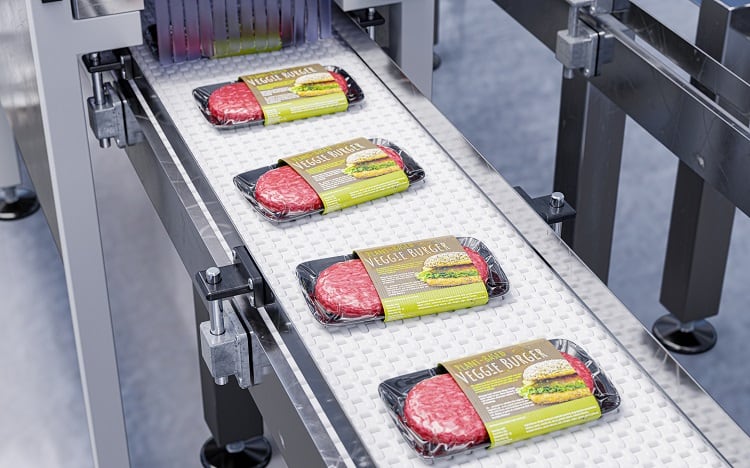Whether described as a slowdown, a shakedown, or the horizontal segment of an ‘S-curve’ graph, fewer consumers are purchasing plant-based meat alternatives.
The cause? Some say the cost-of-living crisis, while others suspect links to ultra-processing is to blame. What most experts seem to agree on is that taste and texture still matter, a lot.
If that’s true, and taste remains king, then what plant-based technologies are letting down the category? And does industry currently have the tools to boost organoleptic experience? FoodNavigator investigates.
Which technologies are letting down the category?
So what is it about taste, texture, appearance, and cooking behaviour that may not be hitting the mark with consumers?
According to US-headquartered Sensient Flavors & Extracts, current technologies are often designed to solve a single, specific problem within the alt meat space. As such, not all issues are resolved, Mathias Bohn, V, senior product & strategy manager, Flavours, Sensient Flavors & Extracts explained.
And when gaps remain, consumers are unwilling to settle – especially when they compare a plant-based product to traditional meat, he suggested.

Taste and nutrition-focused Kerry Group, challenges exist across taste, texture and appearance or colour.
“The primary challenge for developers is masking the ‘off notes’ experienced with plant-based proteins. While the level of ‘off note’ varies significantly from source to source, these can include bitterness, a cardboard or beany taste,” explained Neil McCluskey, global product director, Kerry.
This challenge can be intensified by certain manufacturing technologies designed to texturise proteins, but which can host an ‘uninhabitable environment’ for certain taste components. “Therefore, in a lot of instances, taste is required to be added post-texturisation and this can lead to certain products lacking the depth of flavour that delivers a delicious, well-rounded taste.”
In the plant-based meat category, most texture comes from extrusion methods. But not every extrusion technology or process delivers an equal protein base from which to build texture, explained the product director. If developing a burger, for example, one needs to ensure the textured protein selected is appropriate – it would be very different to that required to replicate fish, for example, McCluskey warned. “There is no one size fits all, so choosing the right technology to deliver the right texture is key.”
Cooking behaviour can also prove a pain point. Consumers often struggle cooking meat alternative products because they don’t always behave in the same way as meat.
“When we cook traditional meat products, we use visual cues such as browning to identify when we have our meat in its desired consumption state,” we were told. “For plant-based products this is much more difficult, resulting in consumers either under or over cooking the product and thereby leading to a very undesirable experience.”
Solutions to these challenges exist, but given the current economic conditions, meat alternative players can find themselves having to choose between spending resources on perfecting their products, or simply keeping their business afloat.
This is what Saffiera Karleen, business development manager, EMEA at Dutch ingredients supplier Corbion has observed. “On top of that, societal expectations concerning sustainability is growing rapidly. For most of the meat players who also produce meat alternatives, they need to split their focus not only to improve the quality of the meat alternative but also on reducing carbon emissions for their meat products.”
As to the technologies themselves, Karleen has seen industry catch up ‘tremendously’ over the last few years to meet plant-based meat demands. “We have seen the rapid growth in variation, brand, and quality of this category on the shelf in the grocery stores.
“I can mention several brands that I would choose over real meat. Though indeed, there is always room for improvement.”
Does industry have the tools to boost taste and texture?
If the need for improvement is a given, do the solutions required currently exist?
Ingredients suppliers are convinced they do. “Absolutely”, responded Kerry’s McCluskey, “albeit we need to continually evolve these proven technologies to maximise our capabilities in a scalable manner.”
And the proof is, at least in part, on-shelf, the product director suggested. “Let’s not forget that there are some fantastic products on the market. Unfortunately, we witnessed such an influx of products as the category began to take off, that brands did not necessarily apply the rigour of consumer acceptance testing to ensure the product was well received – thereby leading to a lot of disappointed consumers.”
As consumers become increasingly demanding in their expectations for alternative proteins, McCluskey stressed that brands will need to ‘keep pace’ in their approach to taste and texture.
“We know that the top motivations consumers have for consuming meat alternatives are concerns over the environment, animal welfare and health. The areas to improve are to bring costs down, improve taste and improve environmental impact.
“We as an industry will have to work harder at communicating some of the areas we have advantages in, as well as continuing to improve.”
Solving taste and texture issues can come with another set of problems, however. Although many people perceive plant-based protein to be healthier and less taxing on the digestive system, more label-focused shoppers ‘fixate’ on high sodium content and the ‘often numerous and complex’ ingredients that go into these products, explained Corbion’s Karleen.
“The intricacy in formulation and labelling of meat analogue products can work against the ‘health halo’ that has boosted this category.”
But as suggested, it’s often the case that the ‘unfamiliar’ ingredients and additives used in plant-based protein play an essential role in providing the attributes that consumers are unwilling to compromise on, such as flavour and texture. This underscores the need for suppliers and manufacturers to work together to find and create consumer-friendly solutions that do not sacrifice organoleptic qualities.
‘Not everyone is asking for meat mimicry’
Ingredient supplier IFF agrees with both McCluskey and Karleen’s perspectives, in that organoleptic profile and nutrition needs must be met. Plant-based meat products must help consumers rebalance their diets and be enjoyable, Sonia Huppert, global innovation marketing leader, Re-imagine Protein, IFF, told this publication.
According to Huppert, despite consumer curiosity and enthusiasm towards the category, many plant-based products are struggling to deliver what shoppers want: taste, health, variety and price.
“This lack of connection to consumers’ values and needs has led to stagnating or declining sales in some markets. Repeat purchases are also sluggish because products don’t meet consumer expectations.
“The industry can’t count on any other driver than taste and texture to attract new customers to the category – and keep them!”
Huppert is convinced there is an ‘immense’ opportunity for mainstream adoption, but being plant-based alone is no longer enough for most consumers. “Not everyone is asking for products mimicking meat. While this approach might help onboard new consumers, it can result in dissatisfaction by inviting ultimately disappointing comparisons with animal-based options.”
But there is another way to attract consumers, believes the global innovation marketing leader. And that is to focus on ‘what might be exciting them’ and to offer ‘novelty’ as well as an enjoyable eating experience.
“With this approach, it’s about creating new dishes that are nutritious, innovative, and close enough to be recognisable to consumers. Focusing on targeted consumer groups and developing what it is that they love could turn the tide.”
What is certain, said Huppert, is that consumer attitudes won’t change if plant-based products only simulate existing fast foods, which don’t fit into every eating occasion. Plant-based brands must offer choices people want at every meal, every day ‘without misgivings’.
“There are solutions available to create delicious plant-based meat products, but they require formulations which need technical knowledge and the right combination of ingredients and solutions.”
Whitespaces for innovation: ingredients players weigh in
Many ingredients suppliers agree that gaps in the technology toolbox exist, and that they have a role to play in providing those solutions.
Innovation whitespace exists across nutrition, texture, flavour, colour, preparation methods and capabilities, and economies of scale, believes Sensient’s Bohn.
“The industry is constantly evolving with new ingredients, processes, formulas, and technologies that are improving the organoleptic profiles of the alternative meat category. Many challenges are still based on the handling, preparation, and consumption of these alternative products,” he told this publication.
Combining ingredients with specific meat mimicking functions can also prove challenging, Bohn suggested. One ingredient might have the right texture but not the right colour or flavour, another might work well in raw form but not when cooked, for example.

Innovation gaps exist in both the short and long terms, according to Kerry. Although the Ireland-headquartered supplier says it is forever on the hunt for new technologies to bridge the consumer expectation gap in relation to texture, these innovations will take time to deliver a scalable and cost-appropriate commercial proposition.
“In the shorter term, we need to drive the category forward by improving the quality of products using existing technologies that addresses taste, nutritional, texture gaps in products on the market today,” said product director McCluskey.
As an example, Kerry’s first- and second-generation plant-based products were based largely on ‘formed’ products, such as meatballs, burger patties, tenders and nuggets. But whole muscle products, such as fillets and chunks, are still a ‘huge’ growth opportunity across emerging and existing markets. “Using [and/or] altering existing technology to deliver meat-like muscle structure can address this gap.”
As to what role ingredients suppliers can play in reigniting excitement in the sector, Corbion points to proprietary research. A survey conducted in June 2023 of 1,100 adults across Europe, the Middle East, and South Africa revealed consumers strongly consider price and flavour/taste (58% and 54% of respondents respectively) as key to their purchase decisions concerning meat alternatives.
This is even more pronounced when asked what prevents consumers from purchasing meat alternatives, noted business development manager Karleen. Price was most prevalent with 63% of respondents, and flavour/taste was at 57%. “These results clearly indicate that ingredients providers have a role to play in providing taste and flavour solutions to help consumers overcome any price barriers to meat alternatives.”
Can plant-based meat reignite consumer excitement with tech innovations alone?
Just how great a role plant-based technology and ingredients can play in reigniting consumer excitement is up for discussion.
Corbion is unconvinced technological innovations alone will be responsible for a plant-based turnaround, unless those innovations also deliver ‘tangible’ reductions in environmental impact for their production.
“According to FMCG Gurus’ 2022 survey on meat and plant-based protein, 81% of EU consumers started eating plant-based products because they believe plant-based is better for the planet. In the US and Australia this was 63% and 51% respectively,” explained Karleen.
“Moreover, the advent of Eco Labelling in the European Union will further drive European consumer awareness.”
Ultimately, innovation must be ‘all-encompassing’ of the challenges faced, Karleen stressed. “Improved solutions that address consumer, regulatory and producer requirements for health, price, flavour/taste and preservation, must equally address environmental considerations.”
IFF believes to bring plant-based meat to the ‘next level’ new technological innovations are required. Similarly to Karleen’s point, IFF’s Huppert believes there also has to be greater understanding of what makes consumers crave meat, along with an identification of the key elements needed to reformulate appealing alternatives.
“Furthermore, options based on new tech – particularly cultured meat or precision fermentation – need to be well positioned and marketed. In addition to taste and texture, nutrition, sustainability, and price need to be factored in to persuade and excite consumers,” we were told.

Kerry predicts we’ll see a ‘huge’ amount of product renovation with consumer expectations in mind. Improving the consumer experience is ‘essential’, McCluskey told us. “While plant-based has become mainstream and household names established, consumer needs are diversifying ahead of what producers [are] delivering.
“We have more work to do to fully meet consumer category expectations. By delivering superior ingredients and finished products that exceed consumer expectations of plant-based meat alternatives, we can convert trial consumers into loyal shoppers and attract new customers to the category.
“This will unlock the most lucrative avenue for revenue generation in this fast-growing market and sustainable growth.”




